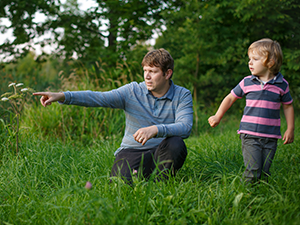Spring Play – Child
 There is so much to see, do, explore and investigate in the ever changing spring world.
There is so much to see, do, explore and investigate in the ever changing spring world.
Playing freely in nature allows children to develop their problem-solving skills and try out new ideas and ways of doing things in a relaxed environment.
When they fall, they learn to get back up again and have another go. Your reassurance builds their confidence and self-esteem.
Did you know?
Children who spend time in nature have stronger coping skills and are more resilient. Springtime is one of the most inviting times to get out into the great outdoors and explore the natural world.
Add language
Ask occasional open-ended questions that encourage more thinking and reasoning. 3-4-year old children can start to use language to classify/group things, to describe things and talk about the function of things. 4-5-year-old children can start to use their language to make basic predictions and to take on the role of another.
Children over 5 years can use language for problem solving, solutions and explanations. You can help build your child’s language skills by using language in observing, exploring and experimenting with the plants, flowers, insects, animals and changing
You can help build your child’s language skills by using language in observing, exploring and experimenting with the plants, flowers, insects, animals and changing natural world in spring. Use specific words to talk about parts of plants e.g. roots, trunks, stems, petals etc. This helps build your child’s word knowledge.
Other development
Running, jumping and climbing, moving around obstacles such as trees, logs and boulders encourages your child to be active. This develops their physical skills and gross motor development. Testing out their own physical skills, trying out more physical challenges and working out risks builds your child’s resilience, strength, endurance, independence and sense of self identity.
Testing out their own physical skills, trying out more physical challenges and working out risks builds your child’s resilience, strength, endurance, independence and sense of self-identity.
As the weather gets warmer in spring, insects and other little animals get more active. This also the prime time for wildflowers. This all makes spring the ideal time to talk about and investigate life cycles. Look for and talk about caterpillars, cocoons and butterflies.
Go bushwalking and investigate the types of wildflowers you see. Take notice of the bees and other creatures visiting these. Encourage and respond to your child’s natural curiosity and exploration. This all builds your child’s general knowledge and science concepts. This also builds their understanding of their world and their place in it.
Go out and find five things you only see in spring. Count how many butterflies or bugs or ducklings you see. Group things you find in nature, compare and contrast them. This all builds your child’s early maths skills.
Visit your local library and share books that link with what your child has been interested in exploring. There are some great non-fiction picture books for young children about life cycles.
The “Very Hungry Caterpillar” is a great picture book story to link to what your child has been investigating outdoors. This helps build early literacy skills and develops an interest in books and reading for information as well as storytelling.
Variations
Spring is the best time for planting flowers, herbs and vegetables. Why not visit your local nursery together to find out what seeds or seedlings to plant and grow? You can use this opportunity to talk about where food comes from and promote healthy eating habits. Even if you only have a small space you can grow edible gardens in pots. Gardening helps to develop your child’s fine motor skills. Strengthening hand and finger control helps develop muscles used for writing and drawing.
Safety
Always use sun protection when playing outside.
The warmer weather tends to make reptiles more active so it is worth being watchful in areas where snakes may live.
Across the ages
All the activities listed on our “Play Ideas” page can be applied across different age groups. See how backyard exploring can be fun for babies, toddlers and playgroups.
Activities listed under “child” are suitable for children 3 years and older. Children of this age enjoy more complex activities where they can develop their skills and use their imagination while playing with friends.

